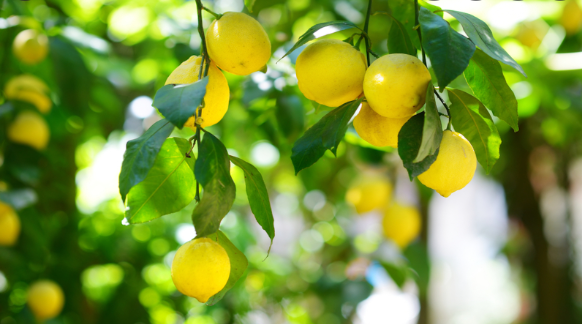Lemon prices have broken all records in the last few days. Usually, the price of lemons sold for Rs 50-60 per kg has reached Rs 300-400 per kg in many cities. Lemon is cultivated on a large scale in areas like Gujarat, Maharashtra, Andhra Pradesh, Madhya Pradesh and Rajasthan. It is getting hot in these areas. Production has been affected due to heat. Transport charges have increased due to rising prices of petrol and diesel. On the one hand, the shortage of lemons and on the other hand the increased transportation charges, both are responsible for inflation.
How much lemon is produced in India
Lemon is grown in an area of 3.17 lakh hectares in India. Lemon trees usually bear fruit three times a year.
Andhra Pradesh is the largest lemon producing state in the country, where lemon is grown in an area of 45 thousand hectares. It is followed by Maharashtra, Gujarat, Odisha and Tamil Nadu in the largest lemon growing states.
There are mainly two categories of lemon in the country – lemon and lime. Small, round and thin peeled paper lemons are the most common variety across the country.
Lime category includes dark green lemons, which are produced for commercial purposes mainly in North and Northeast India.
Annually, more than 37 lakh tonnes of lemons are produced in India, which is completely consumed in the country itself. India neither imports nor exports lemons.
What is the special technology of lemon production in the country ‘Bahar’
Farmers in India use ‘Bahar Treatment’ to produce lemons throughout the year. In spring treatment, farmers stop irrigation and spray chemicals and prune orchards, then resume irrigation by spraying chemicals, which is followed by flowering and then lemon production.
Lemon growers take three springs in a year, namely Ambe, Mrig and Hasta. The names of these springs are decided on the basis of flowering in the lemon plant.
During Ambe Bahar, the fruits are in January-February, while the harvest takes place from April.
In Mrig Bahar, lemon plants grow flowers in June-July, while the fruit takes place in October.
Flowering occurs in September-October in Hast Bahar, while lemon production starts from March onwards.
Farmers are able to produce lemons throughout the year only because of one spring after another.
About 60% of the lemon production in the country is done during Ambe Bahar, that is, in the month of April.
Mrig Bahar produces 30% of the lemons, while the rest of the lemons are produced during Hasta Bahar.
- The matter worsened due to the destruction of two consecutive crops
The main reason for breaking the record of lemon in the country this summer is its low production due to high rainfall and high temperature.
Unseasonal rains, cyclones and extreme heat affected the lemon crop in the top-3 lemon producing states of Andhra Pradesh, Gujarat and Karnataka.
Due to the weather, the two consecutive seasons of lemons, Hast Bahar and the Ambe Bahar that followed, failed. This led to a decline in the production of lemons.
Last year the monsoon was very good across the country, but the months of September and October saw a lot of rain.
Lemon orchards are very sensitive to excess moisture, so the heavy rains in September-October failed the spring season and resulted in very few flowering lemons.
The lemons that come out of hand are usually kept in cold storage and this lemon continues in the market till the lemons of Ambe Bahar arrive.
This time due to low yield in Hast Bahar season, farmers had less lemons to store. Along with this, the lemons of Ambe Bahar also had to face unseasonal rains, due to which its yield was low in the initial phase.
The lemon crop was also affected due to rising temperatures from the end of February, which led to the fall of small lemon fruits.
Usually in summer when the demand for lemon is highest in the year, all the demand is met from the stored hand and fresh Ambe Bahar lemons, but this time due to the impact of both these seasons, production decreased.
Farmers say that this is one of the rarest years when two consecutive springs or seasons of lemon have been affected. Thus, due to low production of lemons, the prices of lemons across the country are breaking records.
- Rise in oil prices in the country
Petrol, diesel and CNG prices have been increasing in the country since March 22. Petrol and diesel prices have increased by up to Rs 10/litre.
The rise in the prices of lemons is also largely contributed by the rise in the prices of oil and CNG.
Experts believe that due to the increase in the prices of petrol and diesel, the transportation cost of lemon has increased by up to Rs 24,000 per truck.
The effect of costly transportation of lemons is visible in the prices of lemons.
- Rising temperature and festivals increased demand
In the month of March itself, the temperature had become like May and the average temperature had reached 38-40 degree centigrade.
Due to this the demand for lemon soon increased further. In February-March itself, due to high temperature, the yield of lemon was also affected.
The demand for lemons also increased during the Hindu festival of Navratri and Ramadan of Muslims, but due to lack of production, the prices of lemons started skyrocketing due to lack of production.
- Cyclone which came in Gujarat last year increased the difficulties
Some experts believe that due to the cyclone that hit Gujarat last year, lemon production was also affected.
Gujarat produces more than 17% of the total lemon yield of the country and is second only to Andhra Pradesh in terms of lemon production.
In such a situation, the effect of affecting lemon production in Gujarat due to cyclone came to the fore in the form of increase in lemon prices.
When will lemon prices fall?
There is little hope of an immediate fall in lemon prices. However, some reduction is expected in the coming days. For the last few days, the prices of lemons in Delhi have come down.
The reason for this is the lemons being shipped from Andhra Pradesh, Karnataka and Telangana, which usually arrive at the end of May, but this time due to high demand and short supply, lemons are being sent from there early.
Although these lemons are green, that is, not yet ripe, but their arrival has raised hopes of a fall in prices. Due to this, there may be some fall in the prices of lemons in the next few days.
Experts believe that the prices of lemon are expected to be completely normal by October, because now the next crop of lemon will be ready by October only. Only after that the inwardness of lemon will improve. Along with this, the arrival of lemons of early spring season is also expected from those areas, where the weather did not hit much in the production of lemons.
What is the condition of record breaking inflation of lemon
Since the last 15 days, there has been a sharp jump in the prices of lemons in the country. Lemon is being sold for Rs 250-400 per kg in most cities of the country and its retail price has reached Rs 10-15 per lemon. In the capital Delhi, lemon is being sold for around Rs 250-300 per kg.
In some other big cities of the country too, the prices of lemons have increased sharply in the last few days. For example, in Mumbai, Hyderabad and Kolkata, the price of lemons that were sold for Rs 50-100 a kg a month ago has now gone up to Rs 300-400/kg.
A bag of 10 kg lemon is being sold for Rs 1,750 in the wholesale market of Pune. Usually a 10 kg bag contains 350-380 lemons. At the same time, the retail price of a lemon in Pune is around Rs 10-15.




